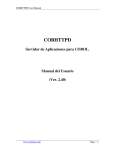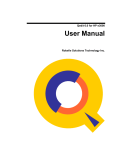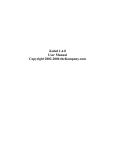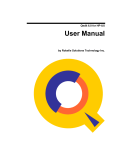Download Qedit Cookbook for Novices
Transcript
Qedit Cookbook for Novices Qedit Cookbook for Novices A Robelle Tutorial Bob Green, August 1995 Copyright 1995, Robelle Solutions Technology Inc. 1 Qedit is Robelle’s full-screen editor for programmers on MPE and HP-UX. Many users have Qedit on their system, but have never seen the manual or attended a Qedit training course. This tutorial is for those who use Qedit every day, but only know the few features shown to them by co-workers. For the Techies You will learn how Qedit can help you solve common programming problems so you can use Qedit more effectively in your work. This tutorial will present real examples with actual input data and output results, then highlight the Qedit features used to obtain these results. For example, we will examine how to tag COBOL source revisions, as well as how to conveniently write and test Quiz reports. You will also learn to use the Hold file to copy lines between files and how to add new user commands to Qedit such as a smart Dir command that can list files on both MPE and DOS. Qedit Cookbook for Novices is written by Bob Green, founder of Robelle. Bob is the programmer in charge of Qedit, and the best person to ask about enhancements. Robelle Solutions Technology Inc. Suite 201, 15399 - 102A Avenue Surrey, B.C. Canada V3R 7K1 Toll-free: 1.888.762.3553 Telephone: 604.582.1700 Fax: 604.582.1799 E-mail: [email protected] References For further information on topics covered in this tutorial, please consult the Qedit User Manual. 1 Qedit is a trademark of Robelle Solutions Technology Inc. Qedit Cookbook for Novices What’s Inside Page n Moving a block of text 3 n Printing text to the LaserJet 5 n Downloading text to your PC 6 n Copying lines from one file to another 7 n Tagging revisions in COBOL source 8 n Editing Copylibs and fixing syntax errors 10 n Selecting string searches 13 n Listing paragraph names 15 n Who is running my program? 17 n Running Quiz on a specific report file 18 This tutorial will teach you how to use Qedit to solve a number of common, non-trivial problems. 2 For the Techies For instance, in the first example we locate a specific block of text, mark it, and then move it to another location in the same file. To find out more about the Qedit commands used in this task (Find String, Forward Page, Update, MM, A), please refer to the Qedit User Manual. We will end the tutorial with an exercise that challenges you to use what you have learned. References 2 Qedit is a trademark of Robelle Solutions Technology Inc. Qedit Cookbook for Novices Moving a block of text n Open file for edit: TEXT or OPEN command n Mark block: MM in screen mode n Search file: F6 for next page, F5 for previous page n Move marked block: A to insert after current line n Save file: KEEP or SHUT command 3 Qedit is a full-screen editor for programmers. Suppose your COBOL program has a declaration in the wrong place and you need to move it to the correct location. You can use Qedit to perform this simple task. First you need to bring the file into Qedit, then you can edit the file and save the changes. For the Techies If you are using standard format editor files for your source code, use the Text command to copy a file into Qedit and the Keep command to save it. If you have converted your source files into Qedit format files, use the Open and Shut commands instead. Qedit files have a code of 111 and store text in a compressed format that can also be edited directly. Convert a file to Qedit format: text filename;shut *; open * Get into Screen mode: press the F1 key or type vis Get back to Line mode: press the F8 key References 3 Qedit is a trademark of Robelle Solutions Technology Inc. Qedit Cookbook for Novices Marking a block of text before moving it n Place MM on the first and last line, then press Enter ===> Okay 54 PROG1.SRC -3 05 item-description pic x(50). -2 -1MM FD line-printer * data record is line-record. +1 01 line-record pic x(132). +2MM // ....+....1....+....2....+....3....+ n To insert text after a specific line, mark an A on it and then press Enter 4 The screen is divided into four parts: the command line (===>), the status line, the text area, and the template line. Within the text area, the current line is marked with an asterisk (*). Lines above the current line are marked -1, -2, -3 and lines below are marked +1, +2, +3. Qedit does not show the actual line numbers since they are usually not needed. Adjust screen size: set vis above 3 below 15 Other cut and paste functions: CC copy DD delete B move/copy before this line Repeatedly insert the same text: Cut and paste operations save lines in a temporary file called Hold0. To copy text from the Hold0 file, use these special functions: A0 insert after this line B0 insert before this line For the Techies On HP-UX, Hold0 is actually called /usr/tmp/qholdBAAa25295.0, but Qedit will find it if you use list hold0. Since UNIX does not have temporary files, it generates the random filename BAAa25295.0. References For a full list of cut and paste operators, type ? in the command line (also the home up position on your screen) and press Enter. 4 Qedit is a trademark of Robelle Solutions Technology Inc. Qedit Cookbook for Novices Printing a block of text on the LaserJet in a two-up format n Use ZZ to mark a block, LIST in the command line, then press Enter ===>list $lp $pcl 10 zz {PCL 10 prints two-up, landscape} Okay 54 PROG1.SRC -3 05 item-description pic x(50). -2 -1ZZ FD line-printer * data record is line-record. +1 01 line-record pic x(132). +2ZZ // ....+....1....+....2....+....3....+ 5 One reason you don't need to see line numbers is the magic marker feature. Using the ZZ command, you can mark any block of text and then execute commands on these lines. ===>change "line-record"linebuf-rec"zz ===>justify format margin 65 zz {format into paragraph} ===>lq $record $shift zz {attached printer} For the Techies Note that List to $lp and $record are not supported in Qedit/UX. Other PCL codes (add 1000 for ASCII, 2000 for A4 paper): PCL 1 - landscape, tiny lineprinter font PCL 2 - landscape, 100 columns, Courier font PCL 3 - portrait, 80 columns, Courier font PCL 4 - portrait, tiny lineprinter font PCL 5 - portrait, Courier tightened for A4 paper Other List options: $double $duplex $page off $include $char $hex double spaced two-sided listing on LaserJet (not HP-UX) without page headings also search $include files suppress control characters show hex values for characters References 5 Qedit is a trademark of Robelle Solutions Technology Inc. Qedit Cookbook for Novices Downloading part of an MPE file to your PC n Use HH to hold block, REFLECT in the command line, then press Enter ===>reflect receive hold.tmp from hold ascii Okay 54 PROG1.SRC -3 05 item-description pic x(50). -2 -1HH FD line-printer * data record is line-record. +1 01 line-record pic x(132). +2HH 6 The HH cut and paste function copies a block of lines into a temporary file called Hold. :listftemp hold,1 For the Techies The :Reflect command is not supported on HP-UX. TEMPORARY FILES FOR BOB.USER,BOB ACCOUNT= USER GROUP= BOB FILENAME CODE -------LOGICAL RECORD-----HOLD * SIZE TYP EOF 1000B FA 4 LIMIT 250000 (TEMP) Reflection: If you are using a Reflection terminal emulator on your PC, you can use Qedit's :Reflect command to execute PC functions under the control of your HP 3000. Upload a file: reflect send host.tmp to host ascii Copy from Hold: AH to insert after this line References BH to insert before this line 6 Qedit is a trademark of Robelle Solutions Technology Inc. Qedit Cookbook for Novices Copying lines between two files n Hold lines from first file: HH marks the first and last lines of a block n Open second file: TEXT or OPEN command n Find insertion point: F6 for next page, F5 for previous page n Copy from Hold file: AH to insert after this line (from Hold) n Save the changes: KEEP or SHUT command 7 You can combine the basic edit functions you have just learned in hundreds of ways to solve many different problems. For the Techies For example, this slide shows you how to copy text from one file to another. References 7 Qedit is a trademark of Robelle Solutions Technology Inc. Qedit Cookbook for Novices Version control through the COBOL comment field n n Set X YYMMDD; Set Lang CobolX ===> Okay 54 PROG1.SRC -3 05 item-description pic x(50). -2 -1 FD line-printer * data record is line-record. +1 01 line-record pic x(132). +2 930922 Revisions are marked with today’s date in columns 73-80 8 Qedit offers a special feature for COBOL users called change tagging. After you enable the Set X command, any further modifications to a COBOL program will be tagged with the current date. Qedit inserts the date in columns 73-80 and lets you see exactly when specific lines were changed. The Set X command is activated only if you are working on a COBOL source file and only after Set Lang CobolX is enabled. For the Techies Qedit recognizes two formats for COBOL source: programs with comment fields (called COBOLX for "eXtended") and programs without comments. Most people omit the comment fields when writing a new program to avoid compile time errors caused by source code inadvertently extending past column 72. To select a format without comments, you can use set lang cobol. If you want to start documenting revisions once a program goes into production, use set lang cobolx to add comment fields. Then you can enable the Set X command to ensure that all subsequent changes to the program are carefully tagged with a date in columns 73-80. Configure Set X every time: References put Set X command into Qeditmgr file 8 Qedit is a trademark of Robelle Solutions Technology Inc. Qedit Cookbook for Novices Qedit supports many date formats and can include programmer initials n n n n n n n n n n n Append initials: Prefix initials: Show the century: Put day first: Put month first: Spell out month: Hide the comments: Force comments: Edit tags manually: Check the tag: Reset the tag: set x yymmdd "ms" set x "ms" yymmdd set x ccyymmdd set x ddmmyy set x mmddyy set x ddmmmyy {22 Sep93} set x list off set lang cobolx all set x tab on verify x set x 9 The Set X command tags all the changed lines in COBOLX files with a string and/or the current date. As you can see above, Qedit supports a wide variety of date formats. Whatever revision tag you select, it appears in columns 73-80 of lines modified or added. For the Techies You can enable the Set X command only if the program has a full record length (80 columns). To hide the comments during normal text editing or listing, use set x list off. You can ensure that all COBOL source files are tagged with comments by using set language cobolx all. This command automatically converts COBOL to COBOLX. In Visual mode, the COBOLX margin is usually set at column 72 to prevent comments from shifting left or right when you make changes to your code. If you have to maintain the comment field manually, this margin setting means you must use the cursor instead of a tab to move to column 72. In order to move to the comment field with a tab, you have to reset the margin from column 72 to column 80 by using set x tab on. References Check the current tag value: verify x Reset the tag: set x "" 9 Qedit is a trademark of Robelle Solutions Technology Inc. Qedit Cookbook for Novices COBOL Copylibs on MPE n Problem: How can I edit a Copylib member? n Answer: Put the member name in parentheses. /:file copylib=copylib.cobsrc /text (custrec) /change "customer"Customer" all /keep 10 COBOL lets you maintain Copylibs or libraries of common source code and data. Each library file consists of several members and each member name can be up to eight characters. You can use HP's Cobedit or Ksamutil to create the original Copylib file and then use Qedit commands (List, Text, Keep and Destroy) to maintain it. For the Techies Qedit/iX supports NM and CM KSAM Copylib files. In order to list or edit a Copylib member, you just need to point a :File command to the Copylib file and then put the member name in parentheses as you would a filename. The first step is almost automatic because most COBOL programmers already have a :File equation for their Copylib file. In the second step, you need to enclose the member name in parentheses before you can use Qedit commands (List, Text, Keep etc.). Since the Keep command defaults to the last name used in the Text command, you don't even have to type the member name when saving your changes. Remember that you need write access to the Copylib file in order to change it. References 10 Qedit is a trademark of Robelle Solutions Technology Inc. Qedit Cookbook for Novices Treating COBOL Copylib members like files n n n n n n n n n List all names: List some names: list (@) list (b@) Look at a member: Edit a member: Update a member: Create new member: Copy to new file: New member, new file: Purge a member: list (custrec) text (custrec) keep (custrec) keep (custrec2) keep (custrec) lib2 keep (custrec2) lib2 destroy (db-base) 11 For the Techies You can use pattern-matching characters in parentheses to list the members in your Copylib. For example, use list (@) to print all the member names, or use list (b@) to list only the names that start with the letter b. Since COBOL compilers require a Copylib file, Qedit looks for the default Copylib through a pointer in the :File equation. To refer to a Copylib member, put the member name in parentheses and Qedit treats it as a filename. list (o2314buf) "order-status" list $lp (02314buf) To refer to other Copylib files, you can state them explicitly instead of changing your :File command. list (dbparms) copylib.cobsrc.newsys list $lp (@) References copylib.cobsrc.newsys 11 Qedit is a trademark of Robelle Solutions Technology Inc. Qedit Cookbook for Novices Getting syntax errors to pop up n Set udc udc.catalog.robelle n :Coberr cob74xl prog1.src (only MPE/iX and MPE/V) ===>RESERVED WORD DATE NOT LEGAL IN THIS DIVISION Okay 54 PROG1.SRC "$ERROR" -3 05 item-description pic x(50). -2 -1 FD line-printer * date record is line-record. +1 01 line-record pic x(132). +2 12 If you would like Qedit to locate errors in your COBOL source files and display error messages, try the :Coberr User Defined Command (UDC). To enable the :Coberr command, use set udc udc.catalog.robelle. Instead of using a regular compile command, the :Coberr UDC specifies an alternate compile command as the first parameter and a source file as the second parameter. :coberr cob74x1,myprog.source :coberr cob85x1,* For the Techies {current file} You use the same syntax as in compiling, but you insert :Coberr in front of the command. For example, instead of typing cob85x1 *, you type :coberr cob85x1,*. The default compile option is Cob85xl, but you can modify your UDC to make it consistent with your own shop. The :Coberr command can also have parameters for the OBJ/USL output file and for the temporary disc file with the compiler listing. References After compiling your source file, Qedit puts you into Screen mode. It places the cursor on the offending word and displays the COBOL error message in the command line. In this example, Qedit puts the cursor on the word "date" because the correct word is data. You can correct the error and press Enter to continue. When you press F4, Qedit goes to the next compile error. 12 Qedit is a trademark of Robelle Solutions Technology Inc. Qedit Cookbook for Novices How to find "customer" without getting "customer-record" n n list "customer" 01 customer-record. 05 customer 05 customer-address 05 customer-phone 05 customer-number 5 lines found pic pic pic pic x(40). x(40) occurs 5 times. x(20). 9(6). list "customer" (smart) 05 customer pic x(40). 1 line found 13 Qedit lets you search for strings within any command (List, Delete, Keep etc.). When you perform a regular string search, you may get a lot of unwanted matches because it includes occurrences where the selected string is embedded in another string. See the "customer" example above. For the Techies Qedit has a Smart option to get around this problem. When you append (S) or (Smart) to a string search, Qedit will only include occurrences where the selected string appears on its own. With the Smart option, Qedit ignores "customer-record" when looking for "customer" because it knows that a hyphen is valid in a COBOL name. Smart is called a string window option. There are other useful window options. Ignore upper versus lower case: list "customer" (upshift) Search a column slice only: list "customer" (5/15) Find lines that don't match: list "customer" (nomatch) Find lines ending in "bob": list "@bob" (pattern upshift) References 13 Qedit is a trademark of Robelle Solutions Technology Inc. Qedit Cookbook for Novices Adding new commands to Qedit n Qedit user command files are just like command files in MPE n Precede Qedit commands with / (slash) n For example, phone.cmd.mis to find phone numbers: parm name /listq phonelst.data.mis "!name" (upshift) if qeditcount = 0 echo No entries found in phone book endif 14 For the Techies You can add new commands to Qedit by creating user command files that contain MPE commands and parameter definitions. Qedit command files are like Shell scripts can be executed in Qedit/UX, those in MPE, except they can also execute Qedit commands (preceded with /). but Qedit/UX does not support command files. You can run a user command file by typing its filename followed by any parameters. If the command file resides on your HPPATH list of groups, you don't need to type the full name. Invoke a command file: /phone ralph String search with parameters: /list file "!name" Test Qedit results: if qeditcount = 0 {automatic JCW} References 14 Qedit is a trademark of Robelle Solutions Technology Inc. Qedit Cookbook for Novices How can I list all my COBOL paragraph names? n Use FIND to get to the start of the Procedure Division /findq "Procedure Division" (upshift) first n Look for a blank in column 7 and an alphanumeric in column 8 /listq " ?" (7/8 pattern) */last 15 This solution assumes that the selected string (Procedure Division) does not occur in comments or in data before the actual Procedure Division. The Listq command searches each line, from the current position to the end of the file, and lists only the lines with a space in column 7 and an alphanumeric character in column 8. The question mark (?) is a pattern-matching character that specifies a single alphanumeric character. For the Techies A handy feature to add to the List command is the J (jumping) option. With this option, Qedit only shows you one screen at a time and then prompts you with More? [yes]:. You can press Return to see the next screen or enter a command to stop the listing. /lqj " ?" (7/8 pattern) */last The pattern-matching characters: @ zero or more characters of any type # exactly one numeric character (0 to 9) ? exactly one alphanumeric character ~ zero or more blank characters & escape character, next character is literal match References ^ and ! reserved for future use 15 Qedit is a trademark of Robelle Solutions Technology Inc. Qedit Cookbook for Novices Creating a command file to list the Procedure Division setjcw cierror 0 /zz */* {save the current line number} continue /findq "procedure division" (8/25 ups) first if cierror <> 0 then echo Warning: No Procedure Division found /listq first endif /lqj " ?" (7/8 pattern) */last /list zz {go back to where we were} 16 In this example, the user command file lists all the procedures in your COBOL source file. You can execute this command file in either Qedit/V or Qedit/iX. Mark current line: /zz */* Go on even if Find fails: continue Jump to marked line: /list zz For the Techies References 16 Qedit is a trademark of Robelle Solutions Technology Inc. Qedit Cookbook for Novices Who is running my program on MPE? n Command file Whorun: parm progname showproc 1;tree;system >pinfile /text pinfile /deleteq "@(!progname@" (pattern upshift nomatch) /changeq 1/23 "" @ {trim first 23 columns} /cq 10/80 "" @ {convert to a list of session numbers} /dq "J" (1/1) {don't list batch jobs} /cq 1 "tell" @ {convert to tell commands} /append "; Please exit from !progname" @ /use * {execute the tell commands} 17 If you don’t have the luxury of MPEX’s :Listf,access command, have you ever wondered who is using a program when you are trying to install a new version? The :Showproc command can show you all the current processes on the system if you have SM capability. To ask all the Qedit users to exit the program, type whorun Qedit. For the Techies This is a listing of Qedit lines produced by the :Showproc command: C155 0:14.152 READY S2192 86 (QEDIT.PUB.ROBELLE) C152 0:43.466 WAIT S2190 149 (QEDIT.PUB.ROBELLE) D202 1:12.597 WAIT J10806 121 (QEDIT.PUB.ROBELLE) D202 0:47.812 WAIT J10805 91 (QEDIT.PUB.ROBELLE) If you remove the first 23 columns, the listing appears as follows: S2192 86 (QEDIT.PUB.ROBELLE) S2190 149 (QEDIT.PUB.ROBELLE) J10806 121 (QEDIT.PUB.ROBELLE) J10805 91 (QEDIT.PUB.ROBELLE) References This is a listing of the non-batch processes converted to :Tell commands: tell S2192; Please exit from Qedit tell S2190; Please exit from Qedit 17 Qedit is a trademark of Robelle Solutions Technology Inc. Qedit Cookbook for Novices Running Quiz on a specific source file n QZ.CMD.USER {definition} parm auto=$null anyparm otherparms=ZZZ file qsource=!auto if "!otherparms"="ZZZ" then quiz "auto=qsource suspend" else quiz "auto=qsource !otherparms suspend" endif file qsource=$null 18 Since MPE versions of PowerHouse modules can read Qedit format files, you do not have to use the Keep command before PowerHouse works on a file. To access Qedit from within PowerHouse, you can use the Revise command to call up the editor through the COGEDITR :File equation. For the Techies Qedit preserves file labels when you use the Text or Keep commands. As a result, you can use Qedit to edit PowerHouse subfiles without damaging the subfile dictionary. Use text filename,labels to copy the subfile, and the Keep command to re-create the labels when you save the files. PowerHouse comes with sophisticated User Defined Commands that allow you to specify almost any Quiz or QTP option. Most of the time, however, you will probably use the same options. In order to minimize typing, it makes sense for you to put frequently used options into a command file. When you invoke Quiz from within Qedit, you may want to select two useful features. The first feature allows you to specify the source filename as a parameter instead of waiting for the prompt to appear. The second feature lets you suspend Quiz when you want to leave it rather than terminating it. If you need to use Quiz later in the same session, this option lets you access it much faster. References 18 Qedit is a trademark of Robelle Solutions Technology Inc. Qedit Cookbook for Novices Examples of invoking PowerHouse command files n qz * n qz abc.source n qp * list=no cc=hpxyz n qd * 19 You can invoke the QZ command file by specifying the source filename as the first parameter. For the Techies /qz srcfile /qz * {current file} /qz $ {last file listed} Notice that when you type qz *, Qedit sends your current workfile to Quiz. When an asterisk (*) is specified, Qedit replaces it with the current file. This is a lot faster than typing the entire filename. If the source file has a lockword, Qedit automatically passes it as a parameter with the filename so you don’t have to respond to the Lockword? question. The syntax qx $ invokes the QZ command file and passes the name of the last Qedit file listed or opened. References 19 Qedit is a trademark of Robelle Solutions Technology Inc. Qedit Cookbook for Novices Command file for Quiz n QZ.CMD.USER parm auto=$null anyparm otherparms=ZZZ file qsource=!auto if "!otherparms" = "ZZZ" then quiz "auto=qsource suspend" else quiz "auto=qsource !otherparms suspend" endif file qsource=$null 20 For the Techies References 20 Qedit is a trademark of Robelle Solutions Technology Inc. Qedit Cookbook for Novices QTP command file n QP.CMD.USER parm auto=$null anyparm otherparms=ZZZ file qsource=!auto if "!otherparms" = "ZZZ" then qtp "auto=qsource suspend" else qtp "auto=qsource !otherparms suspend" endif file qsource=$null 21 For the Techies References 21 Qedit is a trademark of Robelle Solutions Technology Inc. Qedit Cookbook for Novices Command file for Qdesign n QD.CMD.USER parm auto=$null anyparm otherparms=ZZZ file qsource=!auto if "!otherparms" = "ZZZ" then qdesign "auto=qsource suspend" else qdesign "auto=qsource !otherparms suspend" endif file qsource=$null 22 For the Techies References 22 Qedit is a trademark of Robelle Solutions Technology Inc. Qedit Cookbook for Novices Qedit Exercise n Write a DIR command file to list files on your PC or on MPE/iX /dir c:\autoexec.bat {DOS file} /dir q@ {MPE files starting with Q} /dir .\ {DOS cwd} /dir ./ {MPE cwd} /dir \*.bat {DOS root directory} n Use :REFLECT for the PC listings n Use :LISTFILE for MPE listings 23 If you are using a Reflection terminal emulator, you can list files on either your MPE or PC system by creating a Qedit command file named Dir. This command file should have the following parameters: parm fileset= For the Techies anyparm options=0 If Fileset starts with "\" or ".\" or a drive letter such as "c:", assume it refers to PC files. Otherwise, you can use :listfile !fileset. Instead of :Listf, it is better to use the :Listfile command because it also shows files (source-code, Config_file, /mail/inlist) in the POSIX namespace. The key to solving this problem is Qedit's :Reflect command. :reflect dir References 23 Qedit is a trademark of Robelle Solutions Technology Inc. Qedit Cookbook for Novices Considerations n Your command file must examine the first and second characters of the Fileset in order to select between DOS and MPE. Why not extract those characters into variables? setvar lfone lft("!fileset",1) setvar lftwo lft("!fileset",2) if lfone="\" or lftwo=".\" or & alpha("lfone") and pos(":","!fileset")=2 reflect dir !fileset n We do not pass the !options parameter to the :REFLECT command because Reflection's DIR command does not support options such as /w. 24 For the Techies References 24 Qedit is a trademark of Robelle Solutions Technology Inc. Qedit Cookbook for Novices Solution to Exercise n This is one possible solution to the extra credit problem: parm fileset= anyparm options=0 comment DIR = list file on DOS or MPE comment .\ dos the current working directory comment \ dos root directory comment c: dos a specific disk comment comment Anything else does a :LISTFILE setvar lfone lft("!fileset",1) setvar lftwo lft("!fileset",2) 25 For the Techies References 25 Qedit is a trademark of Robelle Solutions Technology Inc. Qedit Cookbook for Novices Solution continued if lfone="\" or lftwo=".\" or & alpha("lfone") and pos(":","!fileset")=2 echo PC Files: comment Reflection does not support DIR options reflect dir !fileset else echo MPE Files: listfile !fileset , !options endif deletevar lfone deletevar lftwo 26 For the Techies References 26 Qedit is a trademark of Robelle Solutions Technology Inc. Qedit Cookbook for Novices Summary of Qedit Cookbook n Screen mode n LaserJet support n PC control through Reflection n COBOL language features n Search power n Command files n PowerHouse convenience n Mix system functions and Qedit edits 27 We hope you have enjoyed this tutorial. For the Techies If you have worked through the entire workbook, you should now be able to do many useful things with Qedit. References 27 Qedit is a trademark of Robelle Solutions Technology Inc.





































